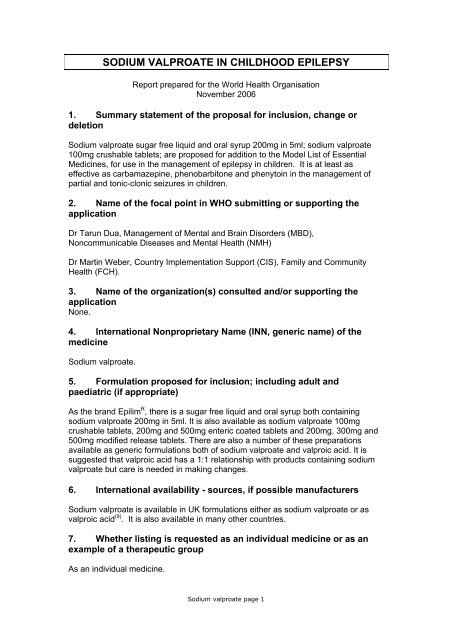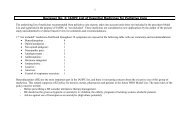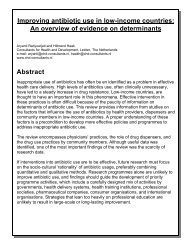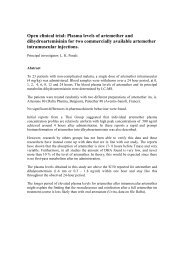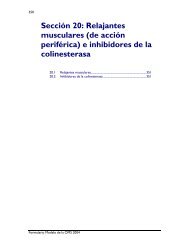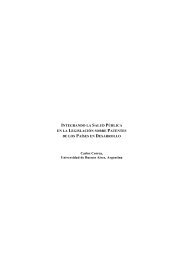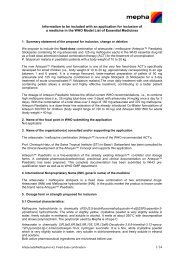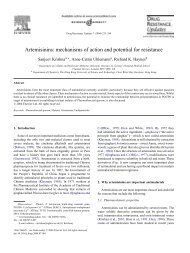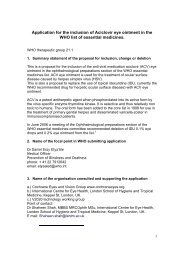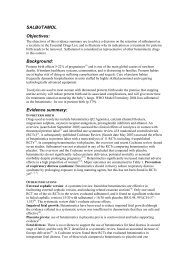SODIUM VALPROATE IN CHILDHOOD EPILEPSY
SODIUM VALPROATE IN CHILDHOOD EPILEPSY
SODIUM VALPROATE IN CHILDHOOD EPILEPSY
Create successful ePaper yourself
Turn your PDF publications into a flip-book with our unique Google optimized e-Paper software.
<strong>SODIUM</strong> <strong>VALPROATE</strong> <strong>IN</strong> <strong>CHILDHOOD</strong> <strong>EPILEPSY</strong><br />
Report prepared for the World Health Organisation<br />
November 2006<br />
1. Summary statement of the proposal for inclusion, change or<br />
deletion<br />
Sodium valproate sugar free liquid and oral syrup 200mg in 5ml; sodium valproate<br />
100mg crushable tablets; are proposed for addition to the Model List of Essential<br />
Medicines, for use in the management of epilepsy in children. It is at least as<br />
effective as carbamazepine, phenobarbitone and phenytoin in the management of<br />
partial and tonic-clonic seizures in children.<br />
2. Name of the focal point in WHO submitting or supporting the<br />
application<br />
Dr Tarun Dua, Management of Mental and Brain Disorders (MBD),<br />
Noncommunicable Diseases and Mental Health (NMH)<br />
Dr Martin Weber, Country Implementation Support (CIS), Family and Community<br />
Health (FCH).<br />
3. Name of the organization(s) consulted and/or supporting the<br />
application<br />
None.<br />
4. International Nonproprietary Name (<strong>IN</strong>N, generic name) of the<br />
medicine<br />
Sodium valproate.<br />
5. Formulation proposed for inclusion; including adult and<br />
paediatric (if appropriate)<br />
As the brand Epilim R , there is a sugar free liquid and oral syrup both containing<br />
sodium valproate 200mg in 5ml. It is also available as sodium valproate 100mg<br />
crushable tablets, 200mg and 500mg enteric coated tablets and 200mg, 300mg and<br />
500mg modified release tablets. There are also a number of these preparations<br />
available as generic formulations both of sodium valproate and valproic acid. It is<br />
suggested that valproic acid has a 1:1 relationship with products containing sodium<br />
valproate but care is needed in making changes.<br />
6. International availability - sources, if possible manufacturers<br />
Sodium valproate is available in UK formulations either as sodium valproate or as<br />
valproic acid (9) . It is also available in many other countries.<br />
7. Whether listing is requested as an individual medicine or as an<br />
example of a therapeutic group<br />
As an individual medicine.<br />
Sodium valproate page 1
8. Information supporting the public health relevance<br />
(epidemiological information on disease burden, assessment of current<br />
use, target population)<br />
Epilepsy is the most common serious neurological disorder and is one of the world’s<br />
most prevalent noncommunicable diseases.<br />
Due to differences in inclusion criteria, classification, diagnosis and case<br />
ascertainment methods, incidence and prevalence rates have varied considerably in<br />
different studies. If febrile seizures, neonatal seizures, single seizures or seizures in<br />
acute illnesses are included, the figures may be elevated several fold.<br />
Data from the WHO (1) indicate there are over 50 million sufferers of epilepsy in the<br />
world today of whom 85% live in developing countries. Globally, there are an<br />
estimated 2.4 million new cases each year and at least 50% of these cases begin in<br />
childhood or adolescence.<br />
Incidence is defined as the frequency of new cases of a disease in a defined<br />
population during a specified period of time (e.g. a calendar year).<br />
When epilepsy is defined as recurrent, unprovoked seizures, the average annual<br />
incidence in developed countries is quoted between 40-70 per 100,000 of the general<br />
population (2,3,4,5,6) .<br />
In developing countries, this figure is much higher at around 100-190 per 100,000 of<br />
the general population per year (4,5,6,7) . The main reason for the higher incidence of<br />
epilepsy in developing countries is the higher risk of experiencing a condition which<br />
can lead to permanent brain damage e.g. parasitic infection such as<br />
neurocysticercosis and malaria; meningitis; pre and perinatal complications and<br />
malnutrition.<br />
The incidence of recurrent seizures is highest in the first year of life and declines<br />
thereafter throughout childhood and adolescence (4) . Incidence decreases from ~ 150<br />
per 100,000 in the first year of life to ~ 60 per 100,000 at ages 5-9 years and 45-50<br />
per 100,000 in older children (27) . Most studies that provide incidence rates separately<br />
for boys and girls find slightly higher total rates for boys (4) . This difference in sexspecific<br />
rates varies by age however as it is suggested that before 5 years, incidence<br />
rates are ~ 30-60% higher in girls than boys while rates tend to be 10-20% higher in<br />
boys through later childhood and adolescence (4) . Sex differences may reflect<br />
differences in predominant seizure types at different ages, differences in exposures<br />
to risk factors because of social differences in the rearing of male and female<br />
children, changes in susceptibility to seizures in boys and girls with age or variations<br />
in diagnosis by sex.<br />
Prevalence is a measure of the number of new and existing cases (both new and old)<br />
of epilepsy in a defined population at either a specific point in time (point prevalence)<br />
or over a defined interval of time such as a year (period prevalence).<br />
Again, like incidence rates, prevalence rates quoted can be influenced depending on<br />
whether persons with single seizures, febrile seizures, acute symptomatic seizures or<br />
only recurrent unprovoked seizures are counted as cases.<br />
The usual prevalence figure quoted is ~ 5-10 cases per 1000 of the general<br />
population (3,4,5,6,7) (excluding febrile convulsions, single seizures and inactive cases).<br />
In children, estimates are of the order of 4-5 per 1000 children (2,4) .<br />
Sodium valproate page 2
Prevalence rates increase with age ranging from ~ 2-3 per 1000 in children up to 7<br />
years of age to 4-6 per 1000 at 11-15 years of age. Rates tend to be slightly higher in<br />
boys than in girls (4) .<br />
Some studies report the prevalence of epilepsy in developing countries to be higher<br />
than that in developed countries with quoted prevalence figures of 10-15 per 1000 of<br />
the general population (4,5,6) . However, Scott RA et al (7) suggests that prevalence rates<br />
for active epilepsy are similar in both developing and industrialised countries. As the<br />
incidence of epilepsy is much higher in the former, it is suggested that a significant<br />
proportion of the affected population in developing countries may be dying from the<br />
seizure disorder or its underlying cause.<br />
Geographic variation has been hard to assess because of a lack of standard<br />
techniques but a consistent finding is that prevalence rates are higher in rural than in<br />
urban areas (3) .<br />
In developed countries, the prevalence of epilepsy is usually found to be slightly<br />
higher in the lower socio-economic groups (3) .<br />
Since the aetiology of epilepsy is frequently multifactorial, the exact attribution of<br />
cause in the general population is often impossible. It has traditionally been said that<br />
60-70% of all epilepsies have no clear cause and these are best referred to as<br />
cryptogenic epilepsies.<br />
The annual incidence of epilepsy is relatively small and few studies have reported<br />
incidence cases by the type of seizure of epilepsy syndrome (4) . It has been<br />
suggested that 1/5th of recently diagnosed children and nearly ¾ of prevalent cases<br />
are reported to have experienced more than one type of seizure. These children are<br />
most often classified according to the predominant seizure type.<br />
Generalised seizures are common in field studies, especially in developing countries,<br />
often because partial seizures are missed. In developed countries, over half the<br />
incidence cases are partial seizures. Partial and generalised seizures vary with age.<br />
Generalised seizures have the highest incidence in the first year of life. With the<br />
exception of absence seizures, for which incidence rates peak in 5-10 year olds, the<br />
incidence of generalised seizures in childhood declines after the first year of life.<br />
Incidence rates for partial seizures increase slightly during early childhood and<br />
remain relatively constant thereafter throughout childhood and adolescence. Among<br />
partial seizures, complex partial seizures are generally the most common (4,6) .<br />
Given the correct treatment, epilepsy responds to treatment in up to 70% of patients.<br />
However, whilst 80% of the potential market for antiepileptic drugs is in the<br />
developing world, it is suggested that around ¾ of these people with epilepsy may<br />
not receive any or receive incorrect treatment. This is thought to be related to<br />
inadequacies in health care resources and delivery and also to the social stigma<br />
attached to the condition (1,5,7) .<br />
Ideally, the choice of antiepileptic drug for each patient should be based on seizure<br />
type and/or the syndrome as well as the individual patient’s needs.<br />
In developing countries however, both the choice and the supply of drugs are limited.<br />
An analysis of the market suggests that while the use of older and cheaper drugs<br />
such as phenobarbitone has declined in developed, industrialised regions, the market<br />
share in developing countries is higher and increasing more quickly than that of the<br />
newer antiepileptic drugs. Alternative anti-epileptic drugs in developing countries are<br />
in very short supply and in such systems, the normal determinants for drug treatment<br />
Sodium valproate page 3
are the drugs cost and availability and not necessarily efficacy and lack of adverse<br />
effects.<br />
Phenobarbitone is the WHO’s first line anti-epileptic drug in developing countries<br />
where it is the most commonly prescribed anti-epileptic drug. Indeed, in their review<br />
Scott RA et al (7) include a number of studies claiming phenobarbitone to be both<br />
effective and tolerated in patients with epilepsy treated in developing countries.<br />
However, whilst it is cheaper than other agents used frequently in developed<br />
countries (e.g. phenytoin, sodium valproate and carbamazepine), questions have<br />
been raised about its suitability with respect to its efficacy and profile of adverse<br />
effects. Certainly, in Europe and the USA, phenobarbitone is no longer considered a<br />
first line drug due to concerns over its efficacy and short and long-term tolerability.<br />
Despite a lack of hard evidence from individual randomised controlled trials, there is<br />
a strong recommendation in Europe and the USA that sodium valproate should be<br />
considered as a first line treatment in generalised, partial and other epilepsies.<br />
9. Treatment details (dosage regimen, duration; reference to existing<br />
WHO and other clinical guidelines; need for special diagnostic or<br />
treatment facilities and skills)<br />
For oral administration an initial dose for infants and children from 1 month to 12<br />
years of age is 5-7.5mg/kg/dose given twice daily. This can be gradually increased,<br />
as necessary, to a usual maintenance dose of 12.5-15mg/kg/dose twice daily.<br />
Clinical chemistry and haematological parameters should be measured if the dose<br />
exceeds 20mg/kg/dose twice daily (9) .<br />
In those aged 12-18 years, an initial oral dose of 300mg/dose twice daily is<br />
suggested increasing in steps of 200mg daily at 3 day intervals to a usual<br />
maintenance dose of 0.5-1g/dose twice daily. The maximum recommended dose is<br />
1.25g/dose twice daily (9) .<br />
Plasma valproate concentrations are not a useful index of efficacy therefore routine<br />
monitoring is unhelpful.<br />
10. Summary of comparative effectiveness in a variety of clinical<br />
settings<br />
The most likely mode of action is the potentiation of the inhibitory action of gamma<br />
amino-butyric acid through an action on the further synthesis or further metabolism of<br />
GABA (8) .<br />
There is a paucity of studies on the comparative efficacy of anti-epileptic drugs in<br />
specific epilepsy syndromes. In newly diagnosed epilepsies, across age groups and<br />
all seizure types, several randomised controlled trials of carbamazepine, sodium<br />
valproate, clobazam, phenytoin and phenobarbitone show they are effective but fail<br />
to identify significant differences in efficacy between these medications.<br />
The potential adverse effects of anti-epileptic drugs should be a major determinant of<br />
the choice of drug in the individual child.<br />
In 1996, de Silva M et al (10) reported on a randomised comparative trial in children. In<br />
this long-term, prospective trial, the efficacy and tolerability of phenobarbitone,<br />
phenytoin, carbamazepine and sodium valproate were compared in 167 children<br />
aged 3-16 years with at least 2 previously untreated tonic-clonic or partial seizures.<br />
Sodium valproate page 4
Children under the age of 3 years and those with myoclonic, absence, tonic or drop<br />
attacks were excluded.<br />
Patients were randomly assigned to one of the four anti-epileptic drugs (identity of<br />
treatment was not masked) and were started on a small dose calculated on body<br />
weight with dosage increments as required and tolerated until seizures ceased or<br />
until the blood concentration was in the top half of the recommended optimum<br />
range. Seizure type and frequency were recorded. If seizures continued,<br />
monotherapy was deemed to have failed and either another drug was chosen by the<br />
physician or a second drug, usually carbamazepine was added.<br />
Efficacy was assessed by time to first seizure after the start of treatment and time to<br />
achieving 1 year remission.<br />
Results showed no significant differences in efficacy between phenobarbitone,<br />
phenytoin, carbamazepine and sodium valproate.<br />
The outcome with each of the drugs was good with 12-25% (overall 20%) of children<br />
remaining seizure free at 3 years follow-up and 60-80% (overall 73%) achieving a 1<br />
year remission by 3 years of follow-up. Comparison of the 4 drugs included an<br />
adjustment for seizure type and analysis showed no significant influence of the two<br />
different seizure categories on the comparative efficacy.<br />
However, randomisation to phenobarbitone was discontinued early in the study<br />
period due to unacceptable side-effects. Six of the first 10 children allocated<br />
phenobarbitone had adverse effects (behavioural or cognitive) that necessitated<br />
withdrawal of the drug. Because of this unacceptably high rate of adverse effects, no<br />
further children were assigned phenobarbitone.<br />
Carbamazepine and sodium valproate were the best tolerated with only 4% of<br />
children discontinuing treatment compared with 9% of children on phenytoin.<br />
Thilothammanl N et al (11) , 1996, conducted a randomised double-blind clinical trial in<br />
India of 151 children (aged 4-12 years) with generalized tonic-clonic seizures.<br />
Patients received phenobarbitone, phenytoin or sodium valproate and at the end of 2<br />
years, 127 children remained in the study. Each child was given one active drug and<br />
2 placebo tablets. The main outcome measures were recurrence of seizures and<br />
side effects. The proportion of children with recurrence did not differ among the 3<br />
groups. More than one side effect was observed in 16 (32%) children on<br />
phenobarbitone, 20 (40%) of children on phenytoin and 9 (19%) of children on<br />
sodium valproate – this difference was statistically significant.<br />
All 3 drugs were equally effective in controlling seizures; side-effects were minimal<br />
with sodium valproate followed by phenobarbitone. Though side effects were more<br />
frequent with phenytoin, most of them disappeared on adjusting drug dosage. Least<br />
expensive phenobarbitone may be preferred as the first drug of choice but only for<br />
pre-school children; sodium valproate is suggested for school children.<br />
A prospective study between carbamazepine, phenytoin and sodium valproate as<br />
monotherapy in previously untreated and recently diagnosed patients with epilepsy<br />
was reported by Callaghan N et al (12) in 1985. 181 patients were randomised to<br />
sodium valproate, phenytoin or carbamazepine as monotherapy and followed for 14<br />
to 24 months. All 3 drugs were highly effective in the control of generalised seizures<br />
but were less effective for partial seizures. No significant difference between the<br />
overall incidence of side effects between the 3 drugs.<br />
In 2001, the Cochrane Collaboration published a systematic review comparing<br />
sodium valproate with phenytoin as monotherapy (13) .<br />
The reviewers include background information suggesting that, although there is no<br />
evidence from randomised controlled trials, it is generally believed that valproate<br />
monotherapy is more effective than phenytoin monotherapy in generalised onset<br />
Sodium valproate page 5
seizures (generalised tonic-clonic seizures, absence and myoclonus) while phenytoin<br />
is more effective than valproate monotherapy in partial onset seizures (simple partial,<br />
complex partial and secondary generalised tonic-clonic seizures).<br />
The object of this review was to assess the best evidence comparing phenytoin and<br />
valproate when used as monotherapy in people with partial onset seizures or<br />
generalised onset tonic-clonic seizures with or without other generalised seizure<br />
types. The review includes randomised controlled trials in children or adults treated<br />
with phenytoin or valproate as monotherapy.<br />
Data were available for 669 individuals from 5 trials, representing 60% of the<br />
participants recruited into the 11 trials that met the inclusion criteria. One important<br />
limitation is that in 4 of the 5 trials, for people classified as having generalised onset<br />
seizures, tonic-clonic seizures were the only seizure types recorded at follow-up and<br />
hence results apply only to generalised tonic-clonic seizures.<br />
The outcome measures included were<br />
- time to withdrawal of allocated treatment (primary outcome) – if treatment<br />
was withdrawn for poor seizure control, adverse effects, non-compliance or if<br />
additional add-on treatment was initiated<br />
- time to achieve 12 month remission (seizure free period)<br />
- time to achieve 6 month remission<br />
- time to first seizure post randomisation<br />
- quality of life measures if available<br />
The following results were:<br />
(a) time to withdrawal of allocated treatment<br />
For people with generalised seizures, there was no clear advantage for either<br />
drug. For people with partial onset seizures, there was a potentially important<br />
advantage for valproate. Overall, there is a suggested potential overall advantage<br />
for valproate.<br />
(b) time to achieve 12 month remission<br />
For people with generalised (tonic-clonic) or partial onset seizures, there was no<br />
clear advantage for either drug.<br />
(c) time to achieve 6 month remission<br />
the most compatible analysis including only generalised tonic-clonic seizures<br />
suggested a potentially important advantage for valproate. For people with partial<br />
onset seizures, there was no clear advantage for either drug. Overall, a potential<br />
overall advantage for valproate is suggested.<br />
(d) time to first seizure post randomisation<br />
the most compatible analysis including only generalised tonic-clonic seizures<br />
indicated no clear advantage for either drug. For those with partial onset<br />
seizures, there was a potentially important advantage for phenytoin. Overall,<br />
results suggest a potential overall advantage for phenytoin<br />
(e) quality of life<br />
This was not recorded in any trial<br />
As such, the review failed to demonstrate a statistically significant effect in favour<br />
of either valproate or phenytoin for the primary global outcome ‘time to withdrawal<br />
of treatment’. This outcome is influenced by the relative efficacy of the 2 drugs as<br />
well as differences in tolerability and safety. There was also a failure to<br />
demonstrate any statistically significant differences between phenytoin and<br />
Sodium valproate page 6
valproate for analysis of ‘time to 12 month remission’ and ‘time to 6 month<br />
remission’.<br />
The results of this systematic review therefore do not provide hard evidence to<br />
overthrow or support the current practice of using valproate for people with<br />
generalised onset tonic-clonic seizures and phenytoin for people with partial onset<br />
seizures.<br />
If future studies are to detect whether particular anti-epileptic drugs are to be<br />
preferred for certain epilepsy syndromes, they will need to be designed and powered<br />
accordingly.<br />
Verity CM et al (14) , on behalf of the Paediatric EPITEG Collaborative Group, reported<br />
on a multicentre comparative trial of sodium valproate and carbamazepine in<br />
paediatric epilepsy. In this, 260 children with primary generalised epilepsy or with<br />
partial epilepsy (with or without secondary generalisation) at 63 outpatient clinics in<br />
the UK and Ireland participated in a 3-year study. Children aged 5-16 years were<br />
included and randomised to receive either sodium valproate or carbamazepine. For<br />
both drugs, treatment was initiated at a fairly low dose and increased as necessary<br />
until seizures were controlled or until toxic symptoms appeared. Maximum daily<br />
dose for sodium valproate was 30mg/kg/DAY and for carbamazepine 20mg/kg/DAY.<br />
No other antiepileptic medication was allowed – the necessity for additional<br />
anticonvulsant medication during the treatment period was classed as treatment<br />
failure.<br />
The analysis of treatment failures (i.e. drug withdrawal following unacceptable<br />
adverse events, inadequate seizure control or both), showed that there was little<br />
difference in failure rates between the drugs. Remission analysis showed that there<br />
was no difference in the overall efficacy between sodium valproate and<br />
carbamazepine in controlling either generalised or partial seizures. Both drugs<br />
achieved a high degree of seizure control with 75% of patients having at least 12<br />
months and 45-55% at least 2 years, of freedom from seizures.<br />
Treatment was withdrawn because of adverse effects in 12% patients on<br />
carbamazepine and 15% patients on sodium valproate. Only 5 (3%) children on<br />
carbamazepine were withdrawn because of rashes in the first few months of<br />
treatment which is far lower than that reported in the EPITEG Study in adults when<br />
9% of patients on carbamazepine had severe rashes.<br />
The above study by Verity et al was included in a Cochrane Review published in<br />
2000 (21) which compared carbamazepine with sodium valproate monotherapy in the<br />
treatment of adults and children with epilepsy.<br />
The studies included in the review were randomised controlled monotherapy studies<br />
comparing carbamazepine and sodium valproate and included children or adults<br />
with partial onset seizures (simple partial, complex partial or secondarily generalising<br />
tonic-clonic seizures) or generalised onset tonic-clonic seizures.<br />
1256 participants from 5 trials (representing 85% of the participants recruited into the<br />
8 trials available) met the inclusion criteria. The intervention was carbamazepine or<br />
sodium valproate monotherapy. The primary outcome measure was time to<br />
withdrawal of allocated treatment (i.e. treatment was withdrawn for poor seizure<br />
control or adverse effects or both, or additional add-on treatment was initiated).<br />
Secondary outcomes were time to 12-month remission from seizures and time to<br />
first seizure post-randomisation.<br />
Results from this review did not find an overall difference between carbamazepine<br />
and sodium valproate for the primary global outcome time to treatment withdrawal.<br />
For efficacy outcomes, the analysis for time to first seizure found a significant<br />
interaction between treatment and epilepsy type, where patients with a partial<br />
Sodium valproate page 7
epilepsy do better on carbamazepine. For time to 12 month remission, results for the<br />
subgroup of people with a partial epilepsy indicate a significant advantage for<br />
carbamazepine, although the test for an interaction between treatment and epilepsy<br />
type was not significant.<br />
Sodium valproate has also been compared with some of the newer antiepeileptic<br />
drugs, notably lamotrigine and topiramate.<br />
Steinhoff BJ et al (15) conducted an open label 24 week monotherapy trial in 239 newly<br />
diagnosed epilepsy patients of 12 years and over. Patients with focal epilepsy were<br />
treated with lamotrigine or carbamazepine and those with generalized epilepsy<br />
received lamotrigine or sodium valproate. The primary efficiency variable was the<br />
number of seizure-free patients during study weeks 17 and 24. There were 63<br />
patients in the generalised epilepsy group of whom 30 received valproate. During<br />
study weeks 17 and 24, 61% of the lamotrigine patients and 84% of the valproate<br />
patients became seizure free. The drop out rate due to lack of efficacy or adverse<br />
effects was 12% with lamotrigine and 3% with valproate.<br />
Coppola G et al (16) also conducted a study comparing lamotrigine with valproic acid.<br />
This was a randomised, open-label parallel group design study of 38 children (3-13<br />
years) with newly diagnosed childhood or juvenile typical absence seizures. Patients<br />
received either lamotrigine (dose gradually increased until seizures controlled or<br />
maximum dose 12mg/kg/DAY) or valproic acid (dose gradually increased until<br />
seizures controlled or maximum dose 30mg/kg/DAY). After 1 month of treatment,<br />
10/19 children taking valproic acid and 1/19 taking lamotrigine were seizure free; by 3<br />
month follow-up 12/19 taking valproic acid and 7/19 taking lamotrigine were seizure<br />
free; at 12 months 13/19 taking valproic acid and 10/19 taking lamotrigine were<br />
seizure free. Side effects were mostly mild and transient and were recorded in 2<br />
children treated with valproic acid and in 6 treated with lamotrigine.<br />
Wheless JW et al (17) reported on a double blind randomised study in which<br />
topiramate, carbamzepine and valproate monotherapy demonstrated similar times to<br />
study exit, times to first seizure and proportions of patients who were seizure-free<br />
during the first 6 months of follow-up. Of the total 613 patients (119 of whom were<br />
children or adolescents), 46% completed the study. Adverse effects accounted for<br />
19% and 23% of discontinuations in the topiramate and traditional therapy arms<br />
respectively. Ineffective treatment accounted for 11% and 12% of discontinuations in<br />
the topiramate and traditional therapy arms. The time to exit and the time to first<br />
seizure did not differ. The proportion of patients who did not experience a seizure<br />
during the last 6 months of the study was 49% of the topiramate patients and 44%<br />
each of the carbamazepine and valproate patients.<br />
Sodium valproate is also sometimes used in the treatment of absence seizures and<br />
the Cochrane Collaboration in 2005 (18) , conducted a systematic review of the<br />
evidence for the effects of ethosuximide, valproate and lamotrigine as treatments for<br />
children and adolescents with absence seizures when compared with placebo or<br />
each other. Studies included were randomised parallel group monotherapy or add-on<br />
trials which included a comparison of any of the following in children or adolescents<br />
with absence seizures. Unfortunately however, of the 5 small trials found, 4 were of<br />
poor methodological quality and did not have a sufficient number of participants.<br />
Sodium valproate page 8
11. Summary of comparative evidence on safety<br />
Adverse Effects<br />
All anti-epileptic drugs have a relatively high incidence of adverse reactions and they<br />
are a major cause of discontinuing treatment. Monotherapy is recommended<br />
wherever possible – monotherapy is effective in controlling the majority of seizures<br />
and adverse effects and interactions are less likely than with the multi-drug<br />
regimens (8,19,20) .<br />
All anti-epileptic drugs are associated with and often cause CNS adverse effects<br />
which include behavioural effects and cognitive dysfunction. This effect is more likely<br />
with polytherapy. Children may be more susceptible to these effects which can have<br />
consequences in terms of difficulty with behaviour, learning and development.<br />
Many adverse effects of anti-epileptic drugs are dose related and may occur at<br />
therapeutic doses. To minimise these, the drug should be introduced at a low dose<br />
and be slowly increased to the minimum dose that achieves seizure control.<br />
The common adverse effects attributable to sodium valproate are<br />
• Hepatobiliary disorders – increased liver enzymes are common, particularly in<br />
early treatment and may be transient (there are very cases of severe liver<br />
dysfunction – see below)<br />
• GI disorders – nausea and diarrhoea occur frequently at the start of treatment<br />
but disappear after a few days without discontinuing treatment. Take with or<br />
after food. Very rare cases of pancreatitis have been reported<br />
• Nervous system disorders – occasionally sedation is reported, usually when<br />
sodium valproate is used in combination with other anti-epileptic drugs.<br />
Hyperactivity and behavioural deterioration have also been reported. Tremor<br />
is reported at high doses.<br />
• Metabolic disorders – cases of isolated and moderate hyperammonaemia<br />
without change in liver function tests may occur frequently, are usually<br />
transient and should not cause treatment discontinuation. However, they may<br />
present clinically as vomiting, ataxia and increasing clouding of<br />
consciousness. If these symptoms occur, treatment should be stopped.<br />
• Weight gain – this is significant and being overweight at the start of treatment<br />
may be a significant predictor of further weight gain with sodium valproate<br />
• Hair loss – usually transient and sometimes dose related. Regrowth normally<br />
begins within 6 months<br />
• Blood dyscrasias – relatively frequent and usually return to normal when<br />
sodium valproate is discontinued<br />
• Reproductive system and breast disorders – amenorrhoea and irregular<br />
periods have been reported<br />
Severe liver damage has been very rarely reported with sodium valproate. Those<br />
most at risk, especially in cases of multiple anticonvulsant therapy, are infants and<br />
young children less than 3 years of age and those with severe seizure disorders,<br />
organic brain disease and/or congenital metabolic or degenerative disease<br />
associated with mental retardation. In most cases, reported liver damage occurred<br />
during the first 6 months of therapy with the period of maximum risk being 2-12<br />
weeks. It is suggested that liver function be monitored before and then periodically<br />
during the first 6 months of therapy, especially in those at most risk and those with a<br />
prior history of liver disease.<br />
In their randomised comparative monotherapy trial of phenobarbitone, phenytoin,<br />
carbamazepine and sodium valproate, de Silva et al (10) found a frequency of<br />
unacceptable adverse effects of 4% for carbamazepine and sodium valproate<br />
Sodium valproate page 9
compared to 9% patients on phenytoin and 60% (6/10) patients given<br />
phenobarbitone. Of the two patients on sodium valproate in whom treatment was<br />
withdrawn, one was due to behavioural side-effects and the other due to tremor.<br />
In his study comparing sodium valproate with carbamazepine, Verity et al (14) showed<br />
a similar incidence of adverse effects and treatment withdrawal between the two<br />
drugs. Treatment was withdrawn because of adverse effects in 12% patients on<br />
carbamazepine and 15% patients on sodium valproate.<br />
Callaghan N et al (12) , also reported no significant difference between the overall<br />
incidence of side effects between carbamazepine, phenytoin and sodium valproate.<br />
(8, 20)<br />
Drug Interactions<br />
(a) Effect of sodium valproate on other drugs<br />
Sodium valproate can affect the plasma concentration of other drugs either through<br />
displacement from plasma proteins (sodium valproate is 80-94% plasma protein<br />
bound) or inhibition of hepatic metabolism<br />
- valproate may potentiate the effect of antipsychotics, MAO inhibitors,<br />
antidepressants and benzodiazepines<br />
- valproate increases phenobarbitone concentrations due to inhibition of<br />
hepatic enzymes and sedation may occur, especially in children<br />
- valproate may also inhibit the metabolism of primidone, carbamazepine and<br />
lamotrigine with potential for increased levels and toxicity of these antiepileptic<br />
drugs<br />
- valproate decreases phenytoin total plasma concentration; valproate<br />
displaces phenytoin from its plasma protein sites and reduces its hepatic<br />
metabolism<br />
- valproate may increase zidovudine plasma concentration<br />
- anticoagulant effect of warfarin and other coumarin anticoagulants may be<br />
increased following displacement from plasma protein binding sites by<br />
valproate<br />
(b) Effect of other drugs on sodium valproate<br />
- Anti-epileptic drugs with enzyme inducing effect (eg phenytoin,<br />
phenobarbitone, carbamazepine) decrease valproic acid concentrations<br />
- Mefloquine and chloroquine increase valproate metabolism and may lower<br />
the seizure threshold<br />
- Levels may be affected by other drugs including macrolide and carbapenem<br />
antibiotics<br />
Plasma valproate concentrations are not a useful index of efficacy therefore routine<br />
monitoring is unhelpful<br />
Use in Pregnancy (8)<br />
In offspring born to mothers with epilepsy receiving any anti-epileptic drug the overall<br />
rate of malformations has been demonstrated to be 2-3x higher than the rate (~3%)<br />
reported in the general population. An increased number of children with<br />
malformations have been reported in cases of multiple drug therapy.<br />
Developmental delay has been reported in children born to mothers with epilepsy; it<br />
is not possible to differentiate what may be due to genetic, social, environmental<br />
factors, maternal epilepsy or antiepileptic treatment.<br />
Sodium valproate page 10
Risk with valproate<br />
- associated with neural tube defects such as myelomenigocele and spina<br />
bifida<br />
- frequency of this effect is estimated to be 1-2%<br />
- increased incidence of minor or major malformations (incl neural tube<br />
defects, craniofacial defects, limb malformations, CV malformations,<br />
hypospadias) has been reported in offspring born to mothers with epilepsy<br />
treated with valproate<br />
- association between in-utero exposure to valproate and risk of<br />
developmental delay, particularly of verbal IQ<br />
Folate supplementation prior to pregnancy has been shown to reduce the incidence<br />
of neural tube defects<br />
Anticonvulsant monotherapy is preferred with lowest effective dose<br />
Incidence of neural tube defect rises with increasing dosage, particularly above<br />
1000mg daily<br />
Use in Lactation (8)<br />
Excretion of valproate in breast milk is low with a concentration between 1-10% of<br />
total maternal serum levels. Appears to be no contraindication to breastfeeding<br />
13. Licensed Status<br />
Sodium valproate has a product licence in Europe and the USA for the treatment of<br />
generalised, partial and other epilepsies in adults and children. There is no lower age<br />
limit specified for its use either as monotherapy or as adjunctive therapy. However,<br />
due to an increased risk of severe liver damage, it is not recommended as a first line<br />
therapy in infants less than two years of age and use of sodium valproate in this age<br />
group is generally reserved for more difficult cases.<br />
14. Availability of pharmacopoeial standards (British Pharmacopoeia,<br />
International Pharmacopoeia, United States Pharmacopoeia)<br />
British Pharmacopoeia.<br />
15. Proposed (new/adapted) text for the WHO Model Formulary<br />
To be provided.<br />
Sodium valproate page 11
References<br />
(1) WHO – Epilepsy Facts<br />
(2) Prodigy Guidance 2006<br />
(3) www.e-epilepsy.org.uk. The incidence and prevalence of epilepsy. Institute of<br />
Neurology, UCH, London<br />
(4) Cowan LD. The epidemiology of the epilepsies in children. Mental Retardation<br />
and Developmental Disabilities Res Reviews, 2002; 8: 171-181<br />
(5) WHO Fact Sheet 165, February 2001. Epilepsy: aetiology, epidemiology and<br />
prognosis<br />
(6) WHO-Epilepsy Atlas 2005<br />
(7) Scott RA et al. The treatment of epilepsy in developing countries: where do we<br />
go from here? Bulletin of the WHO, 2001; 79(4): 344-351<br />
(8) SPC – Epilim R – Accessed October 2006 via Electronic Medicines<br />
Compendium<br />
(9) British National Formulary for Children 2006<br />
(10) De Silva M et al. Randomised comparative monotherapy trial of<br />
phenobarbitone, phenytoin, carbamazepine or sodium valproate for newly<br />
diagnosed childhood epilepsy. Lancet 1996; 347: 709-713<br />
(11) Thilothammanl N et al. Comparison of phenobarbitone, phenytoin with sodium<br />
valproate: randomised, double-blind study. Indian Pediatr, 1996; 33(7): 549-555<br />
(12) Callaghan N et al. A prospective study between carbamazepine, phenytoin and<br />
sodium valproate as monotherapy in previously untreated and recently<br />
diagnosed patients with epilepsy. J Neurol Neurosurg Psychiatry 1985; 48: 639-<br />
644<br />
(13) The Cochrane Collaboration 2001 – Phenytoin versus valproate monotherapy<br />
for partial onset seizures and generalised onset tonic-clonic seizures (Review)<br />
(14) Verity CM et al. A multicentre comparative trial of sodium valproate and<br />
carbamazepine in paediatric epilepsy. Dev Med Child Neurol, 1995; 37: 97-108<br />
(15) Steinhoff BJ et al. The LAM-SAFE Study: Lamotrigine versus carbamazepine or<br />
valproic acid in newly diagnosed focal and generalised epilepsies in<br />
adolescents and adults. Seizure, 2005; 14(8): 597-605<br />
(16) Coppola G et al. Lamotrigine versus valproic acid as first-line monotherapy in<br />
newly diagnosed typical absence seizures: an open-label, randomised, parallel<br />
group study. Epilepsia, 2004; 45(9): 1049-1053<br />
(17) Wheless JW et al. Topiramate, carbamazepine and valproate monotherapy:<br />
double-blind comparison in newly diagnosed epilepsy. J Child Neurol 2004;<br />
19(2): 135-141<br />
(18) The Cochrane Collaboration 2005 – Ethosuximide, sodium valproate or<br />
lamotrigine for absence seizures in children and adolescents (Review)<br />
(19) Prodigy Guidance 2006<br />
(20) Guerrini R. Valproate as a mainstay of therapy for pediatric epilepsy. Pediatr<br />
Drugs, 2006; 8(2): 113-129<br />
(21) The Cochrane Collaboration 2000 – Carbamazepine versus Valproate<br />
Monotherapy for Epilepsy (Review)<br />
Sodium valproate page 12


